MSI 970 Gaming Motherboard Review: Undercutting AM3+ at $100
by Ian Cutress on January 22, 2015 10:00 AM EST- Posted in
- Motherboards
- AMD
- MSI
- Vishera
- AM3+
CPU Performance
Readers of our motherboard review section will have noted the trend in modern motherboards to implement a form of MultiCore Enhancement / Acceleration / Turbo (read our report here) on their motherboards. This does several things, including better benchmark results at stock settings (not entirely needed if overclocking is an end-user goal) at the expense of heat and temperature. It also gives in essence an automatic overclock which may be against what the user wants. Our testing methodology is ‘out-of-the-box’, with the latest public BIOS installed and XMP enabled, and thus subject to the whims of this feature. It is ultimately up to the motherboard manufacturer to take this risk – and manufacturers taking risks in the setup is something they do on every product (think C-state settings, USB priority, DPC Latency / monitoring priority, memory subtimings at JEDEC). Processor speed change is part of that risk, and ultimately if no overclocking is planned, some motherboards will affect how fast that shiny new processor goes and can be an important factor in the system build.
As it stands, it would seem that while the MSI 970 Gaming does not implement any form of MultiCore Turbo, its turbo mode is a lot more aggressive than our previous data points in most benchmarks.
Point Calculations – 3D Movement Algorithm Test: link
3DPM is a self-penned benchmark, taking basic 3D movement algorithms used in Brownian Motion simulations and testing them for speed. High floating point performance, MHz and IPC wins in the single thread version, whereas the multithread version has to handle the threads and loves more cores. For a brief explanation of the platform agnostic coding behind this benchmark, see my forum post here.
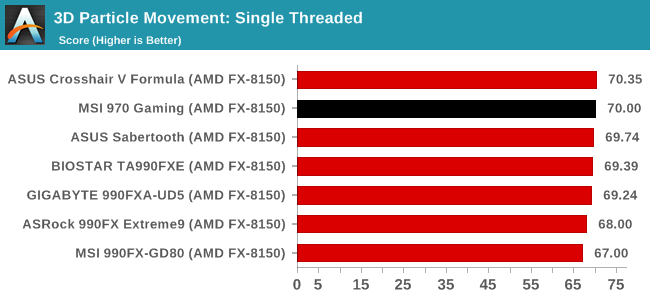
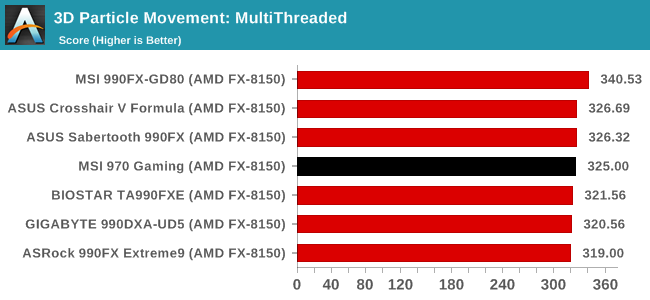
‘More aggressive turbo’ for 3DPM means a 2% jump in both ST and MT scores over the Extreme9.
Compression – WinRAR 5.0.1: link
Our WinRAR test from 2013 is updated to the latest version of WinRAR at the start of 2014. We compress a set of 2867 files across 320 folders totaling 1.52 GB in size – 95% of these files are small typical website files, and the rest (90% of the size) are small 30 second 720p videos.
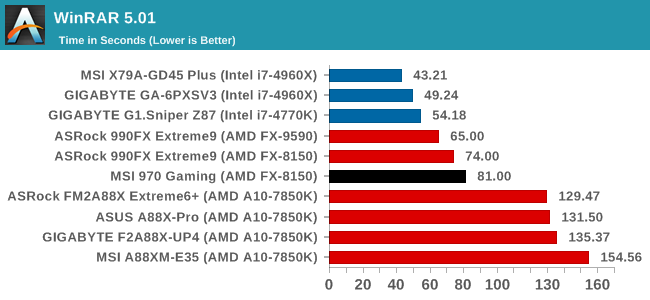
One benchmark where the turbo fails is in WinRAR, which uses a multithreaded load. We tracked the CPU MHz during this test and it did not show anything toward, perhaps indicating a more auto-memory timing issue. The 970 does come as standard with a slower HyperTransport link, which might be one of the reasons for the discrepancy.
Image Manipulation – FastStone Image Viewer 4.9: link
Similarly to WinRAR, the FastStone test us updated for 2014 to the latest version. FastStone is the program I use to perform quick or bulk actions on images, such as resizing, adjusting for color and cropping. In our test we take a series of 170 images in various sizes and formats and convert them all into 640x480 .gif files, maintaining the aspect ratio. FastStone does not use multithreading for this test, and thus single threaded performance is often the winner.
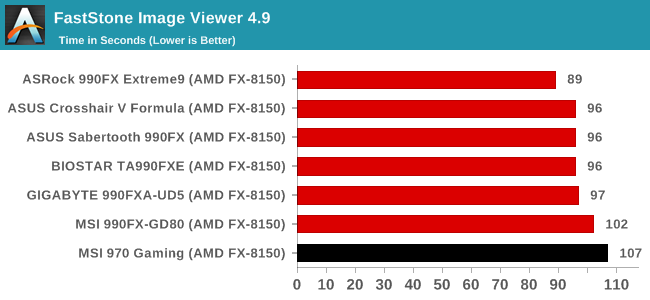
In line with the WinRAR result, the FastStone result was down the pan compared to the Extreme9 and other 900 series boards. FastStone is typically all CPU MHz related, especially single thread, which shows perhaps something fundamental with the 970 Gaming BIOS coding.
Video Conversion – Handbrake v0.9.9: link
Handbrake is a media conversion tool that was initially designed to help DVD ISOs and Video CDs into more common video formats. The principle today is still the same, primarily as an output for H.264 + AAC/MP3 audio within an MKV container. In our test we use the same videos as in the Xilisoft test, and results are given in frames per second.
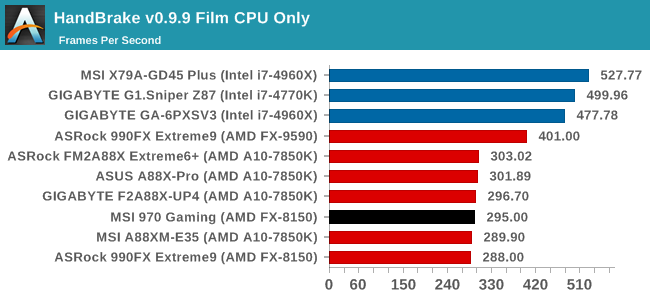
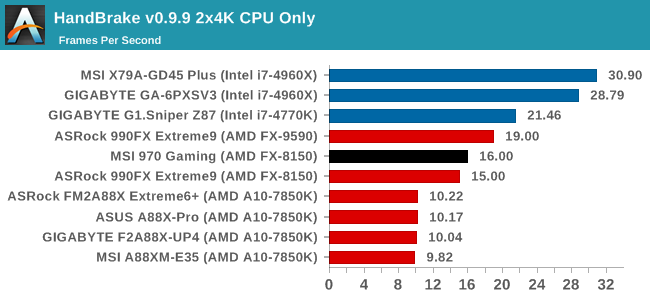
When the system ramps up all the cores, performance from the board is back on track, giving the same percentage increases over the Extreme9 as in the 3DPM benchmark.
Rendering – PovRay 3.7: link
The Persistence of Vision RayTracer, or PovRay, is a freeware package for as the name suggests, ray tracing. It is a pure renderer, rather than modeling software, but the latest beta version contains a handy benchmark for stressing all processing threads on a platform. We have been using this test in motherboard reviews to test memory stability at various CPU speeds to good effect – if it passes the test, the IMC in the CPU is stable for a given CPU speed. As a CPU test, it runs for approximately 2-3 minutes on high end platforms.
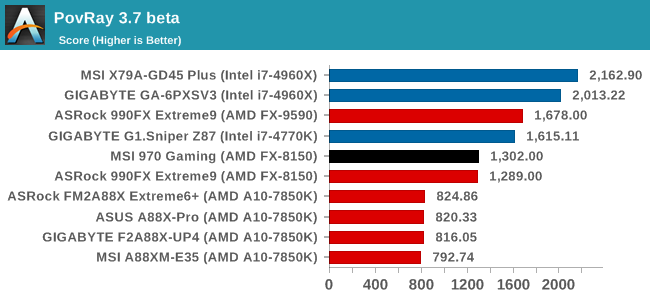
Synthetic – 7-Zip 9.2: link
As an open source compression tool, 7-Zip is a popular tool for making sets of files easier to handle and transfer. The software offers up its own benchmark, to which we report the result.
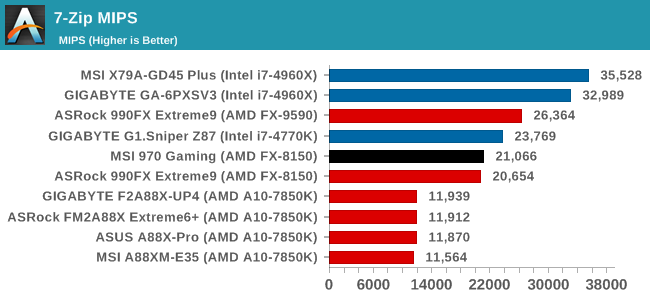










37 Comments
View All Comments
200380051 - Friday, January 30, 2015 - link
THAT. No 9 Series mATX boards whatsoever, and only a few AM3+ mATX boards with a decent power stage (even 4+1 phases). That's too bad. I, for one, could put one such board to good use.frenzy55 - Wednesday, January 28, 2015 - link
"The 970 chipset limits the user to a single NVIDIA GPU and PCIe 2.0,"MSI's website says they support SLI and I am currently running 2 Radeon 7770's in crossfire with this board.
frenzy55 - Wednesday, January 28, 2015 - link
Also, their site claims x16 + x8.Phartindust - Thursday, January 29, 2015 - link
Yeah Ian, the board does support AMD GPUs too. LOLecuakd - Wednesday, April 29, 2015 - link
can this motherboard handle 4k fine?arizona - Monday, October 19, 2015 - link
hey averyone i got something to ask does this motherboard can it run windows 7 please let me knowvikash124 - Wednesday, December 30, 2015 - link
msi 970 usb 3.0 drivers not working please help